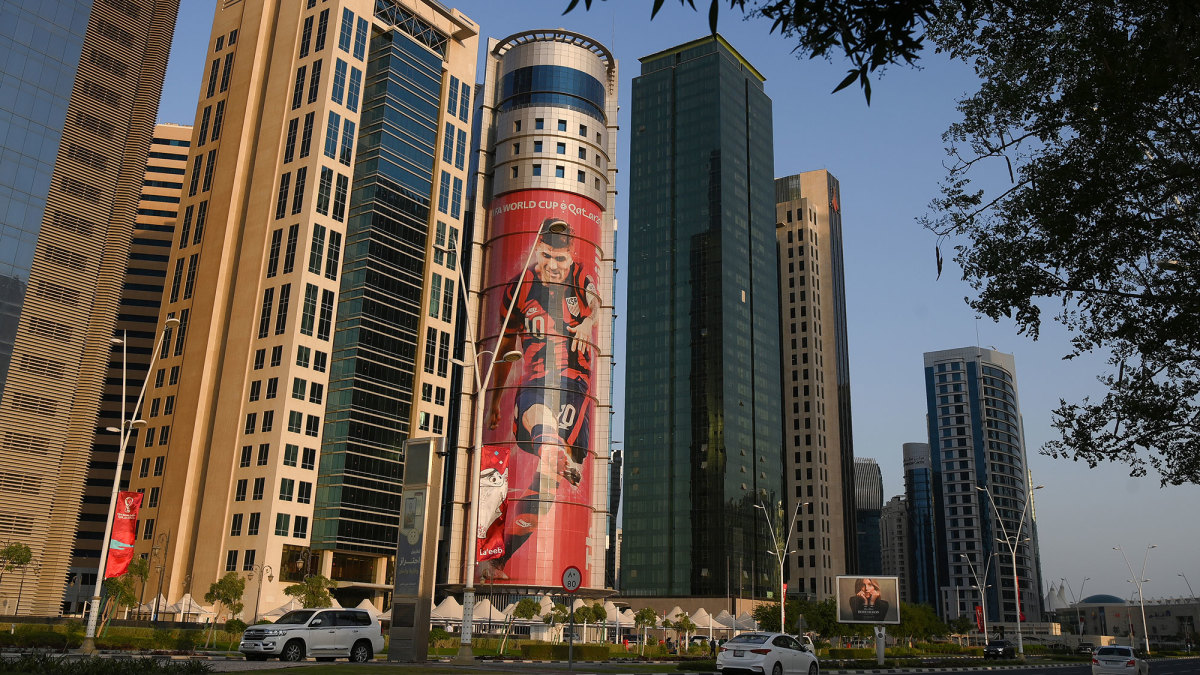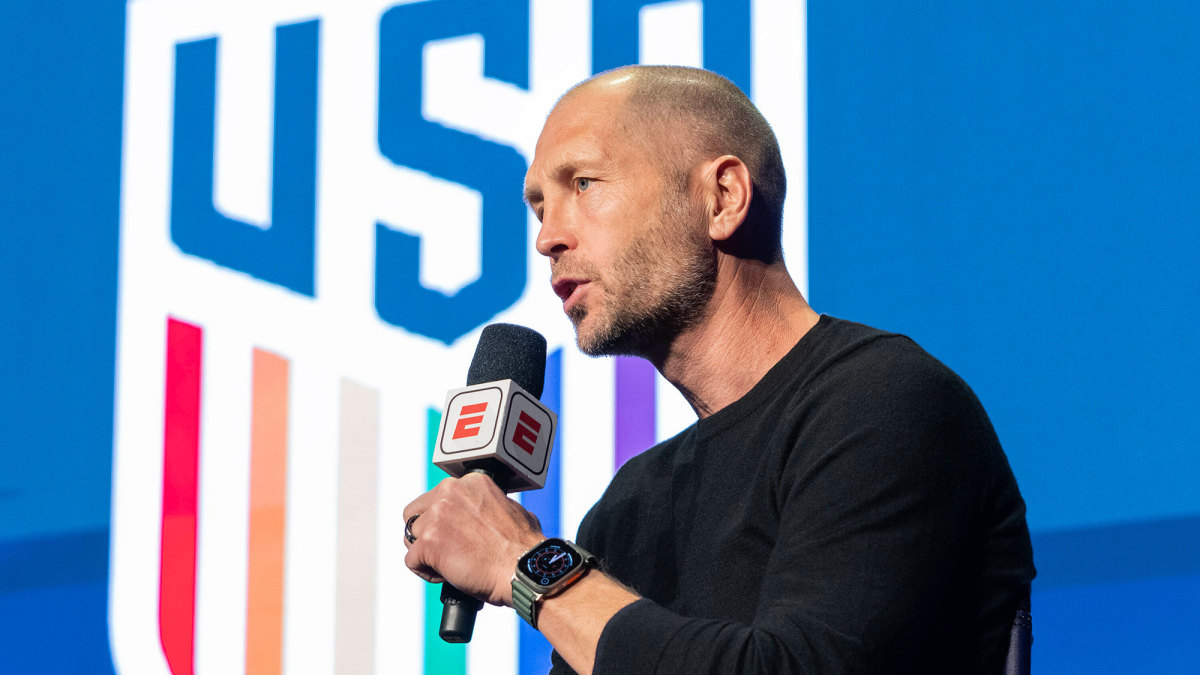USMNT’s Comfort, Values Prioritized in Qatar As World Cup Prep Begins in Earnest
AL RAYYAN, Qatar — Close to 2:30 in the afternoon, a prayer call coming from a speaker somewhere in this neighborhood on the outskirts of Doha wafted into the Thani bin Jassim Stadium.
There’s nothing especially noteworthy about this modest 20-year-old, 21,000-seat facility, whose seats are colored in the blue and yellow of seven-time national champ Al Gharafa SC. It’s a low, ovular bowl with gradually sloping stands that resembles many arenas of its size and type around the world.
But the prayer call was less familiar to the U.S. players training inside, and it was a timely reminder that the waiting, buildup and anticipation is almost over. After eight years, the U.S. is in Qatar and back at the World Cup, and Monday’s training session was the first at which coach Gregg Berhalter had nearly his entire squad available. It also comes exactly a week before the Americans open Group B play against Wales at a stadium located just eight miles away.
“Everybody’s super excited to get here and get going,” goalkeeper Sean Johnson said inside the press conference tent located on the property’s southwest corner. “The first few days has been incredible and just really, as the guys get integrated and seeing their faces again, really [great] just getting to be with everybody. Being here, it’s my first experience, and I’m looking forward to a fantastic World Cup. I’m just happy to get going.”
No case of the Mondays here. #USMNT x @BioSteelSports pic.twitter.com/FIxPwvq3aV
— U.S. Soccer Men's National Team (@USMNT) November 14, 2022
The U.S. practiced Monday with 22 of its 26 rostered players. Defender Sergiño Dest, midfielder Weston McKennie and forwards Tim Weah and Haji Wright were scheduled to arrive later in the day. McKennie has missed Juventus’ past four matches with a quadriceps injury, but Berhalter said here that his recovery is “going really well” and that the 24-year-old is expected to be able to participate.
“I think with the players that are projected to be healthy, I think we’re pretty good,” Berhalter said. “Obviously, with Wes, we’re going to look at it tomorrow. We expect him to be O.K., but we’ll see. But that’s exciting. I think as we go through the tournament, our goal is to get stronger.”
The group stage at this World Cup is going to be shorter than usual thanks to the November-December timing—nine days instead of the traditional 11. That means a little less time between games, a little less time to prepare and, if things go wrong, potentially a little less time in the country. Berhalter said Monday that while the team and staff were focused on the Welsh, there was little choice but to consider how they might also navigate the group stage as a whole.
“Today we got some good work in on the field, and we’re starting to give them some details about Wales and how we're going to look to play against them, and then we’ll move forward and focus on England and Iran,” the manager said. “It’s important that we do put focus into this Wales game, but we'll also be working on general concepts that we want to work on. So it’ll be both.”

Berhalter isn’t planning for a shorter stay, however. U.S. Soccer began looking into its Qatari accommodations before the 2018 World Cup kicked off. Managing director of administration Tom King took nine trips to the country to scout out hotels and training facilities, and Berhalter began getting involved three years ago. FIFA pairs practice sites with specific hotels, and when the request process began three years ago, King immediately jumped on Al Gharafa and the team hotel located about nine miles away on The Pearl, the artificial island in Doha’s northeast.
“We went to a lot of lengths to make it accommodating to create the type of environment that the players are used to, and understanding that we want to be here for a long time. So we want to make it comfortable,” Berhalter said.
The hotel features the players’ lounge, barbershop and barista to which the American men have become accustomed under Berhalter. U.S. Soccer also brought a full-time chef, an Italian whom the players and staff met in El Salvador when World Cup qualifying started last year. Thani bin Jassim also comes with perks. Berhalter and King chose it in part because of what’s already there: a game-quality field, locker rooms, meeting rooms, dining and media areas that allow the U.S. to have just about everything it needs in one spot. The federation then constructed a covered, open-air gym a few meters from the field. On Monday, several players were on stationary bikes or ellipticals as training got underway.
“The field is great. Obviously having everything in one place, having the top-class gym to prepare as well,” said Johnson, the New York City FC keeper. “It’s my first experience—wouldn’t be able to compare it to other World Cups obviously. But this so far has impressed me in terms of the setup and as players getting the best environment to really prepare properly.”
U.S. Soccer added a few additional flourishes designed to make the players feel more welcome in this unfamiliar environment and another that represents their own call to action. Federation branding is everywhere, from the wall coverings in the stadium hallways to the national team crests affixed to doors throughout the complex. The conversation starter can be found in a smaller media room where players will conduct interviews throughout their stay: a floor-to-ceiling mural reading “ONE NATION.” and featuring the multicolor Pride version of the national team logo.
The media / press conference room at Al Gharafa, and a room for smaller player interviews with rainbow branding pic.twitter.com/whvhmMpV9t
— Brian Straus (@BrianStraus) November 14, 2022
“We’ve tried to continue to have discussions as we lead into the games,” Johnson said. “I think we’ve leaned on the message of ‘Be the Change.’ That’s something that we’ve been really proud of and obviously continue to work towards being impactful with ourselves, with our presence, with our platform, and we’ll continue to do so here in Qatar.”
“Be the Change” is the campaign the U.S. players launched following the 2020 murder of George Floyd in Minneapolis. It began with team and individual messages emblazoned on pregame warmup jackets and evolved into initiatives like a June 2022 letter to the U.S. Congress asking for legislation designed to curb gun violence. Along with the women’s national team, the U.S. men have also backed the LGBTQ community with rainbow-numbered jerseys and other signs of support.
“It’s a sign of our values and what we represent as the men’s national team and U.S. Soccer, and we’re a group that believes in inclusivity. We’ll continue to project that message going forward,” Johnson said Monday.

“We’ve been talking to the team for the last 18 months about Qatar, about some social issues in Qatar,” Berhalter explained. “We think it’s important that when we are on the world stage and you are in a venue like Qatar, it’s important to bring awareness to these issues.
“We recognize that Qatar has made strides, and there has been a ton of progress. But there’s still some work to do. ‘Be the Change’ basically represents everyone’s individual opportunity to make change and have change start with them. So I think it’s appropriate that we have it here as well.”
On Tuesday afternoon, the U.S. will welcome 20 local migrant workers who were involved in World Cup infrastructure construction to the Thani bin Jassim for a meet and greet with players and some small-sided games. Following that, the Americans’ attention will turn back toward Wales.
